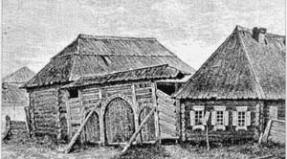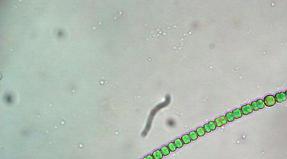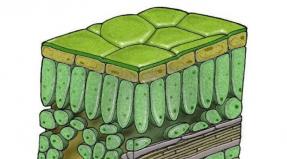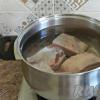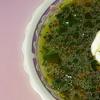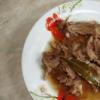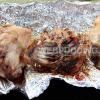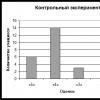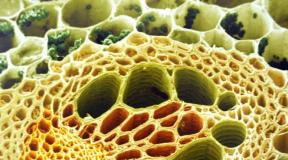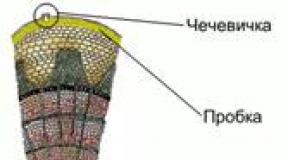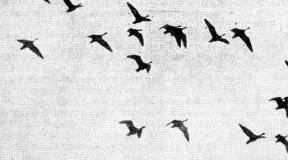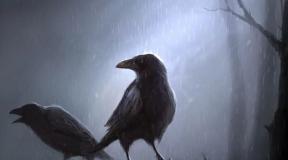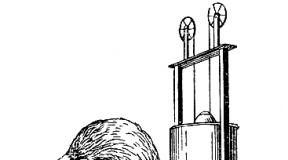Finding letters in various plot images. Practical material on the development of visual perception. b) clarification and expansion of the volume of visual memory
Development of visual perception
Visual perception is a complex job, during which a large number of stimuli acting on the eye are analyzed. The more perfect the visual perception, the more diverse the sensations are in quality and strength, and therefore the more complete, accurate and differentiated they reflect the stimuli. A person receives the bulk of information about the world around him through vision.
Visual perception is a complex process that includes various structural components: volition, purposefulness, visual-motor coordination, visual examination skills, analytical and synthetic activity of the visual analyzer, volume, constancy of perception.
Visual images, like any mental images, are multidimensional and complex; they include three levels of reflection: sensory-perceptual, level of ideas and verbal-logical level. As studies show, the formation of any level of visual reflection in children with intellectual disabilities is impaired (E. S. Bein, K. I. Veresotskaya, etc.). Briefly characterizing the main disorders, we note that the visual images of such children are impoverished, often deformed and unstable. Children with intellectual disabilities have difficulty identifying an object's constituent parts, proportions, and unique structure; they may miss important details (for example: a watch without a screw); They do not always accurately recognize color and shades of color. In the process of recognizing objects and phenomena familiar from past experience, they exhibit generalized recognition, identification of objects that have some similarity, distortion and inadequacy of ideas about the surrounding reality. In children with intellectual disabilities, visual representations differ significantly from real objects. Many inaccuracies appear during perception under changed conditions (a new perspective of an object) and the reproduction of several similar objects. The ideas that such children develop without the regulating participation of a teacher are poor, unclear, fragmentary, and erroneous. Research shows that the description of the objects in question also suffers, since it is not formed without special training.
The accuracy and effectiveness of visual perception and the preservation of a visual image in memory ultimately determine the effectiveness of the formation of writing and reading skills. Violations of visual perception lead to difficulties in identifying figures, letters, numbers, their size, the relationship of parts, clearly differentiating the differences and similarities of similar configurations or mirror elements, etc. It should be noted that the immaturity of visual perception often lies in the fact that it is a deficiency not a single visual or motor function, but a deficit in the integrative interaction of these functions.
Insufficient development of visual perception in younger schoolchildren leads to a lag in the formation of spatial orientation. In visual-spatial perception, the oculomotor system plays an important role - speed, accuracy of oculomotor reactions, the ability to converge the gaze of both eyes, binocular vision. The oculomotor system is involved in the analysis and assessment of subsequent changes in such spatial properties as the position of objects in the field of view, the size and distance of objects, their movements, and various relationships between objects. The deficit in visual-spatial perception of children with intellectual disabilities is also explained by the inferiority of the interaction of various functions of vision: its acuity, perceptual field, eye.
However, practice shows that with targeted and systematic work, insufficiency of visual and visuospatial perception can be significantly reduced. This work is aimed at solving the following tasks:
- formation of adequate visual images of objects, objects and phenomena of the surrounding reality, their position in space;
- expansion of the volume, accuracy and completeness of visual perceptions and visual memory;
- developing the skills to observe an object (including a moving one), visually examine it;
- improving hand-eye coordination;
- formation of skills of verbal description of visually perceived objects and objects, their properties, phenomena of reality.
Individual characteristics of the development of visual perception and visual memory largely determine the nature of correctional work with children. The most accessible for students' perception are real objects and their images, more complex are schematic images, signs and symbols. Last but not least, materials with a superimposed, “noisy”, under-drawn image are used.
Let us note that children’s full-fledged visual perception develops in the process of learning and repeated consolidation of acquired skills and learned methods in various situations and on different objects. That is why numerous examples of didactic exercises and games (see below) should be used in different versions (perhaps even created by the teacher himself).
Let's consider options for tasks for the development of visual perception, based on the principles of gradual complication:
- examination of individual volumetric objects with a gradually more complex structure;
- comparison of natural three-dimensional objects and objects (2-4), distinguished by clearly expressed characteristics (color, shape, size, number of parts, location of individual parts, etc.), then comparison of their images;
- recognition of realistic images from different angles;
- examination of individual flat objects along a contour with a gradually more complex structure, with collapsible parts (parts);
- comparison of contour images of objects and objects (2-4), distinguished by clearly expressed features (color, shape, size, number of parts, location of individual parts, etc.);
- comparison of natural similar objects and objects (2-4), differing in minor characteristics (structure, number of parts, shades of the same color, size, location of individual parts, etc.), further comparison of their images;
- comparison of contour images of objects and objects (2-4), differing in minor characteristics (color, shape, size, number of parts, location of individual parts, etc.);
- recognition of an object by its part;
- examining plot pictures, highlighting plot lines (it is possible to use absurdities as a complication);
- examination of two plot pictures that differ in minor elements.
The complexity of tasks can be achieved through the use of superimposed, “noisy” crossed out, under-drawn contour images, an increase in the number of perceived real objects (objects) and their images for memorization (from 2-3 to 6-7), the use of graphic and abstract images (including number of letters, numbers and their elements).
Work should begin with developing the ability to purposefully examine, i.e. visually examine. Under the guidance of a teacher, children isolate the main elements and details of an object, determine their relationship, position in space, and notice changes in the object itself or its location. At the same time, we emphasize that viewing or recognizing objects and their images by children with intellectual disabilities requires a longer time, as this is due to the slowness of the processes of analysis and synthesis characteristic of them.
The following exercises contribute to the development of visual analysis and synthesis, voluntary visual attention and memorization:
- determination of changes in a number of items;
- finding a “dropped out” or “extra” toy or picture;
- finding differences in two similar plot pictures;
- finding unrealistic elements of ridiculous pictures;
- memorizing 4-6 objects, toys, pictures, geometric shapes, letters, numbers and reproducing them in the original sequence.
Particular attention is paid to coordinating the exploratory movements of the child’s hands and eyes, following with his gaze the actions of the hand, and subsequently moving objects in space. Visual-motor coordination effectively develops when performing various motor exercises: walking and running along markings, riding a bicycle, riding a scooter on paths and limited areas; throwing various objects at a target in the games “Flying Saucers”, “Flying Caps”, “Darts”, “Ring Throw”, “Hit the Target”.
It is possible to use special exercises related to stencil tracing, silhouette and contour images. For example:
-
Circle as many squares as you can hear sounds.
- Circle 7 circles on the top strip, and 2 more triangles on the bottom strip.
- Color the second, fourth and sixth squares on the top line red, and shade the third, fifth and seventh squares on the bottom line.
- In different places of the sheet, circle the toy stencils along the outer or inner contour, and then connect them with paths.
It is advisable to begin observing moving objects in space by determining changes in the position of individual moving parts of toys, for example, a doll (hands, legs), a car (body, doors), a house (windows, doors), etc. Three-dimensional, planar, detachable, prefabricated toys and objects having one (or several) movably fixed parts. In the process of operating with them, the child gradually acquires visual images of movement and posture, which are further consolidated in the process of independently performed movements and actions as shown by an adult, from memory, from a model diagram, from verbal instructions.
Board games “Hockey”, “Basketball”, “Football”, “Billiards”, “City Roads”, etc. contribute to the formation of the ability to follow moving objects with the gaze and at the same time evaluate their position in space.
We emphasize that children with intellectual disabilities master the skill of observing several moving objects through repeated performance of specially selected exercises. First, surveillance of two objects is organized (where is the mouse, where did the bunny run? Which way did the truck go, and which way did the fire truck go?
Etc.), gradually the number of objects increases and the direction of their movement becomes more diverse.
The most difficult thing for children’s visual perception is determining the distance, extent to an object, volume, depth of space, identifying the relationship and movement of various parts (objects) in the perceived space, changing their position. It is important to teach children to measure objects in space, determine their own location, and simulate various spatial situations. For this purpose, exercises are used to develop the eye:
-
Determine how many steps to the desk, to the doll, to the intersection (on the street), etc.; who sits further: Kolya or Marina; who is taller: Sasha or Tolya, etc.
- Select by eye objects that are in the same ratio in size to each other as in the sample (two nesting dolls of contrasting size).
- Show the relationship of two objects in height using columns (stripes), etc.
- Divide a circle, square, rectangle into 2, 4, 3 equal parts.
- Cut the ribbon into equal parts.
As children master the methods of measuring distance using a meter, you can complicate the tasks by asking them to determine the distance in centimeters or meters by eye. It is also possible to use exercises and games for spatial orientation (see below).
The educational psychologist should remember that the optimal combination of the amount of verbal and visual information, repeated exercises for each of the above positions stimulate and improve children’s visual perception. At the same time, the verbalization of the actions performed helps to consolidate the received ideas.
Work to activate visual functions should be built taking into account the requirements of hygiene and the prevention of visual impairment. The reasons for decreased visual acuity are different, but the main one is eye strain during exercise. Experts believe that even children with normal vision need to regularly perform a set of exercises to relieve eye strain and provide an opportunity for rest for the eyes.
Visual acuity largely depends on the systematic training, so such exercises should be mandatory in all correctional classes. Let's give examples.
The teacher reads a poem and the children do exercises.
Buratino stretched (children stand on their toes, raise their hands and look at their fingertips), turned right, left, looked down, looked up (without turning their heads, look right, left, down, up) and quietly sat down.
During visual gymnastics in class, children approach the window, look into the distance, note near and far, high and low, thick and thin, wide and narrow objects and objects, fixate with their gaze the named color for a certain time (5-10 s), etc. .
Didactic games and exercises
for the development of visual perception
"What changed?"
The child is asked to look at several cards with letters (words, numbers, geometric shapes, etc.) and turn away (leave the room). The teacher removes (adds or swaps) cards. The child determines what has changed.
"Find the error"
The child is offered a card with incorrect spellings:
words
- one letter is written in a mirror way (missed, extra one inserted);
examples
- an error was made in the calculation, the figure was written in a mirror image, etc.;
proposals
- a word that is inappropriate in meaning (similar in spelling, etc.) is omitted or inserted.
The child explains how to correct this mistake.
"Find differences"
Children are asked to look at paired pictures with signs of differences (cards of letters and numbers with different spellings, different images of the same geometric shapes, etc.) and find these signs of differences and similarities.
"Sign table"
Children are asked to show numbers of a certain color on a colored table in ascending (descending) order over a certain time.
"Overlay Images"
The child is presented with 3-5 contour images (objects, geometric shapes, letters, numbers) superimposed on each other. All images must be named.
"Hidden Images"
Present figures consisting of elements of letters and geometric shapes. You need to find all the hidden images.
"Noisy images"
They present contour images of objects, geometric figures, numbers, letters that are noisy, that is, crossed out by lines of various configurations. They need to be identified and named.
"Paired Images"
Present two object images that are very similar in appearance to each other, but have up to 5-7 minor differences. You need to find these differences.
Options:
- paired toys are used;
- present an object and its image.
"Unfinished Images"
Present images with unfinished elements, for example, a bird without a beak, a fish without a tail, a flower without petals, a dress without a sleeve, a chair without a leg, etc. You need to name the missing details (or complete the drawing).
Options:
- they present images in which only part of the object is drawn (or its characteristic detail), it is necessary to restore the entire image.
"Bitmaps"
Present images of objects, geometric shapes, letters, numbers made in the form of dots. It is necessary to name them.
"Inverted Images"
Present schematic images of objects, letters, numbers, rotated 180°. You need to name them.
"Cut Images"
Present parts of 2-3 images (for example, vegetables of different colors or different sizes, etc.). It is required to assemble whole images from these parts.
Options:
- offer pictures with images of various objects, cut in different ways (vertically, horizontally, diagonally into 4, 6, 7 parts, curved lines).
"Remember and Draw"
The child is asked to memorize a series of 4-6 objects, and then draw them schematically.
"Little letters"
They offer several rows of randomly arranged letters of the alphabet. You need to find and circle with a pencil (or underline):
- all letters I;
- all vowels;
- all the letters B are in one color, and all the letters P are in another color.
"Find the letter"
In the text, the child is asked to underline the letter A with one line, all the letters N with two lines, and put a dot under the letter O.
“Where did the flashlight come on?”
The teacher lights a flashlight in different places in the room, the child must determine its location.
Options:
- count how many times the flashlight lights up.
"Fold the pattern"
Fold the same pattern as suggested by the teacher, and also make a variety of patterns from Kos and Nikitin cubes.
"Locker"
Material:
a cabinet made from matchboxes with pull-out drawers.
In front of the child, a small toy is hidden in one of the drawers. After 15-20 minutes, the child is asked to find it.
Options:
- hide 2-3 toys at the same time;
- find the toy hidden in the drawer according to verbal instructions.
Favzana Ayupova
The formation of reading skills is necessary for further successful learning at school. But not all children quickly master this skill. This is partly due to the fact that children are poorly remember the visual image of the letter, they confuse similar spellings letters, they are written in mirror images. This leads to low reading efficiency and lower levels of reading comprehension. In order for the child to firmly grasp letters, you can do the following with your children games and exercises.
1. Naming letters. Children become familiar with the fact that sound can be represented graphically, i.e. letter. We name the letters briefly, no overtones "s", "uh", we demonstrate a black and white printed version.
Children find the named letters on the faces of the cubes
2. Please tell me what it looks like letter. Children compare letter with real objects, figures, numbers, animals, people. Thanks to children remember the features of letters more easily. You can offer a poetic text to describe the graphic letter image:
F - A beetle flies over a meadow
He was tired of walking.
Z – letter"Z"- padlock,
We are looking for a key in addition to it.

Letters"G" I'm not afraid
Letter"G" is not an evil goose, but a kind goose!

3. After analysis letters(what elements does it consist of? letter how these elements are located in space, you can use counting sticks, ropes, matches to lay out this letter. Feeling the volumetric letter(made of polystyrene foam, recognize it with your eyes closed.

4. To develop tactile perception, outline letters made from velvet paper.

5. To secure letter image you can use the following methods We: tracing the stencil letters;

cutting letters with scissors;

modeling from plasticine,

laying out from seeds.
For automation sound-letter connections can be offered didactic games:
Pantomime "Live letter» (children depict the letter with the whole body) ;

- Draw the letter with your fingers;


Definition letters written on the back, palms: “What I wrote the letter?» ;

Recognition letters written in different fonts;
Finding letters in various plots images.

This work in " Letter workshop" gives its positive results: children are good remember letters and don’t confuse them.
Literature
T. E. Kovrigina, R. E. Sheremet, Entertaining teaching of reading, Volgograd, 2007
Formation of prerequisites for optically literate reading and writing in children with speech pathology
Vanifatieva N.V. – teacher-speech therapist of MDOU d/s No. 36 “Yakorek”
Sokolova L.A. – Head of MDOU d/s No. 36 “Yakorek”
Slobodenyuk E.V. – deputy manager according to VMR MDOU d/s No. 36 “Yakorek”
Among the variety of written language disorders, the most common are optical dyslexia and dysgraphia. These disorders may result from the action of various harmful factors during the pre- and postnatal period of development of the fetus and child, which can lead to a delay in the formation of certain functional systems involved in the processes of reading and writing.
One of the most common causes of optical pathology of written speech is a hereditary predisposition, as a result of which the child, according to L.S. Tsvetkova, inherits the qualitative immaturity of cells in the parieto-temporo-occipital and premotor-frontal regions of the cerebral cortex. Difficulties in developing the lateralization process can also cause the occurrence of optical dyslexia and dysgraphia. A laterality that is not formed in time, as well as a cross-formed one, reveals that the dominant role of one of the cerebral hemispheres has not been established, therefore, the leading hand is not clearly defined, which leads to a disruption in the analysis of space. As a result, children do not master the system of abstract spatial designations (right, left, right, left, etc.), get confused in the symmetrical sides of space, and do not completely master spatial concepts. As a result, spatial perception, orientation and ideas are insufficiently formed.
A.N. Kornev (1997), R.I. Lalaeva (1999), I.N. Sadovnikova (1995), M.E. Khvattsev (1996) and others, among the mechanisms of optical disorders of written speech, highlight underdevelopment of visual gnosis, analysis and synthesis, optical-spatial perception and representations, visual-motor coordination, insufficient formation of visual attention and memory.
In children with speech impairment, defective speech activity affects the formation of such mental processes as perception, attention, and memory. The lack of development of the basic prerequisites for optically literate reading and writing in children with speech disorders can be identified even in preschool age, and corrective and preventive work will prevent the development of these disorders or sharply reduce their severity.
It is possible to assume the occurrence of optical difficulties in reading and writing in preschoolers with speech impairment based on the following characteristic difficulties:
1 – a longer process of the child’s assimilation of the color and shape of objects;
2 – difficulties in differentiating tint colors and their verbal designation;
3 – difficulties in perceiving and recognizing silhouette images of objects, as well as differentiating objects by external similarity;
4 – difficulties in recognizing contour images of objects superimposed on each other;
5 – has difficulty finding all the differences in the images of objects;
6 – they do not always recognize and recall previously seen images of objects or plot pictures;
7 – delay in the development of orientation in one’s own body;
8 – difficulties in arranging objects in space, according to an image and according to verbal instructions;
9 – difficulties in determining the spatial position of parts of objects and images;
6 – when reading, replacing sounds depicting graphically similar letters.
When typing letters in class or on their own, children may not complete the elements, depict the letters in a mirror, or miss a letter if they do not select a graphic symbol for it.
Based on the listed mechanisms of optically literate written speech, it is possible to determine the directions of correctional and preventive work.
It is advisable to divide correctional and preventive work into two periods. During the preparatory period, the basic prerequisites underlying optically literate reading and writing are formed. During this period, the leading role is given to the teacher. In his classes, the teacher conducts exercises for the development of visual gnosis, visual-motor memory and coordination, spatial concepts, and finely coordinated hand movements. During the main period, during speech therapy classes on literacy, work is carried out on automation and differentiation of graphically similar letters in printed font. Consolidation of these skills is carried out by the teacher and parents. The teacher reinforces these skills in subgroup and individual lessons with children, and parents refine these skills at home with their children using the speech therapist’s home notebooks.
Contents of the main directions of speech therapy work on the prevention of optical dyslexia and dysgraphia in preschool children with speech pathology:
Preparation period
1. Formation of visual gnosis (perception and recognition) based on the material of objects. Visual materials on lexical topics were compiled. For each topic, the images were systematized in the following order:
Color image of objects;
Silhouette image;
Outline image;
Dotted image;
Unfinished image;
Overlaid images on top of each other.
These magazines can be used in teacher classes on speech development, speech therapy classes and individual ones.
2. Development of the ability to concentrate and switch visual attention.
3. Development of visual and visual-motor memory.
4. Formation of spatial perception, visual-spatial analysis and synthesis, spatial representations.
5. Formation of temporary orientations and ideas.
6. Development of hand-eye coordination.
7. Development of finely coordinated hand movements.
Main period
Target: to form a generalized image of a letter in children and automate this skill using various graphic materials.
Stages of work:
1. Development of letter gnosis, analysis and synthesis.
2. Automation of mixed letters.
3. Differentiation of mixed letters.
Areas of work:
1. Formation of the skill of finding letters among non-letter images.
2. Formation of the skill of recognizing letters written in a stylized manner.
3. Formation of the skill of recognizing letters written in different fonts.
4. Formation of the skill of finding letters in plot images.
5. Formation of the skill of recognizing dotted letters.
6. Formation of the skill of recognizing letters in conditions of graphic noise.
7. Formation of the skill of recognizing letters upside down in space.
8. Formation of the skill of recognizing letters hidden in images of objects.
9. Formation of the skill of recognizing letters under overlapping conditions.
10. Formation of the skill of recognizing unfinished letters.
11. Formation of the skill of differentiating optically similar letters.
12. Formation of the skill of recognizing correctly and incorrectly written letters.
13. Formation of the skill of constructing and reconstructing letters from elements.
In addition, a list of verses is offered that describe the graphic image of the letter and the simple position of the letter. It is recommended to use poetry at the stage of familiarization with the letter to form generalized ideas about the graphic sign.
Directions are implemented during literacy classes, individual speech therapy classes, and in classes of teachers of speech therapy groups.
The developed visual material for the formation of each of the listed areas is systematized from simple to complex.
On each graphic material, variants of various tasks are possible. The sequence of letters corresponds to the requirements of the T.B. program. Filicheva, G.V. Chirkina “Education and training of preschool children with phonetic-phonemic underdevelopment.”
When designing visual material, we took into account its accessibility to children’s perception, aesthetics, and the possibility of multifaceted use.
Task No. 1."Finding letters among non-letter images."
Material:(graphic material sheets No. 1-7).
Possible instructions:
Look and find the letter among the signs (sheets No. 1-2).
Look and find letters among the signs (sheets No. 3-7).
Name this letter.
Find these letters among the letters of the alphabet.
Close with a letter from the cut alphabet.
Task No. 2."Recognition of letters written in a stylized manner."
Material:(graphic material sheets No. 8-21).
Possible instructions:
Look and name what letter this image looks like (sheets No. 8-19).
Cover the fun image with a letter from the cut alphabet.
- Show all the letters similar to (the speech therapist points to the required letter) (sheets No. 13-16).
Look and name what letter this dotted image looks like (sheets No. 17-19).
Find the same letter among the letters of the alphabet.
Find the same letters, but different in size. Name these letters (sheets No. 20-21).
Find the same letter among the letters of the alphabet.
Look and name the image: (sheets No. 8-15).
In the upper left corner
In the upper right corner
In the lower left corner
In the lower right corner.
Find the same letter among the letters of the alphabet.
Look and name the images: (sheets No. 8-15).
In the first line
In the second line
In the third line.
Look and name the dotted images: (sheets No. 17-19).
Cover them with letters from the cut alphabet.
Look and name the images: (sheets No. 8-10).
In the second column
In the third column
In the fourth column.
Find the same letters among the letters of the alphabet.
Cover them with letters from the cut alphabet.
Task No. 3.“Recognizing letters written in different fonts.”
Material:(graphic material sheets No. 22-34).
Possible instructions:
Look and name what letter this image looks like (sheets No. 22-34).
Find the same letter among the letters of the alphabet.
Cover this image with letters from the cut alphabet.
Look and name the letter:
In the upper left corner
In the upper right corner
In the lower left corner
In the lower right corner.
Find this letter among the letters of the alphabet.
Cover them with letters from the cut alphabet.
Look and name the letters:
In the top (first) line
In the bottom (second) line.
Cover them with letters from the cut alphabet.
Task No. 4.“Reading words consisting of letters depicted in a stylized manner and in different fonts.”
Material:(graphic material sheets No. 35-39).
Possible instructions:
Look and name what letters these images resemble. Read the word.
Make a word from the letters of the split alphabet.
Make a phrase from the words of the split alphabet. Read it.
Task No. 5."Finding letters in plot images."
Material:(graphic material sheets No. 40-53).
Possible instructions:
Look and name which letters are hidden in the pictures (sheets No. 40-48).
Show all the letters. Count how many letters (A, etc.) you saw?
Find the same letters among the letters of the alphabet.
Look, find and name what letters are hidden “at the bottom of the sea”? (L, M, N, R) (sheet No. 49).
Find the same letters among the letters of the alphabet.
Look, find and name what letters are hidden in the “forest thicket”? (X, C, Ch, Shch) (sheet No. 50).
Find the same letters among the letters of the alphabet.
Look, find and name what letters are hidden in the “cave”? (B, P, V, F, G, K, D, T, Z, S, W, F) (sheet No. 51).
Look, find and name all the letters you saw in the picture? (sheets No. 52-53).
Find the same letters among the letters of the alphabet.
Task No. 6.“Recognition of dotted letters.”
Material:(graphic material sheets No. 54-59).
Possible instructions:
Look and name the letters.
Find the same letter among the letters of the alphabet.
Cover the dotted image with a letter from the cut alphabet.
Show me the letter that I will name (the speech therapist gradually increases the number of letters called).
Name the letter that I will show you (the speech therapist gradually increases the number of letters).
Look and name the letters:
In the first line are sheets No. 56-59
In the second line
In the third line. sheets No. 54-55
Find the same letters among the letters of the alphabet.
Cover them with letters from the cut alphabet.
Look and name the letters:
In the first column (top - down, bottom - up)
In the second column
In the third column
In the fourth column
In the fifth column.
Find the same letters among the letters of the alphabet.
Cover them with letters from the cut alphabet.
Task No. 7."Recognition of letters in conditions of graphic noise."
Material:(graphic material sheets No. 60-80).
Possible instructions:
Look, the letter is hidden. Which letter is hidden?
Name this letter. Find it among the letters of the split alphabet.
Show me where the letter is hidden... ((A) the speech therapist names a specific letter, gradually increasing the number of letters).
In the top (first) line
In the bottom (second) line.
Find the same letters among the letters of the alphabet.
Cover them with letters from the cut alphabet.
Tell me which letters are hidden:
In the first column (top - down, bottom - up)
In the second column
In the third column
In the fourth column
In the fifth column.
Find the same letters among the letters of the alphabet.
Cover them with letters from the cut alphabet.
Tell me which letter is hidden:
In the top left corner
In the lower left corner
In the upper right corner
In the lower right corner.
Find the same letters among the letters of the alphabet.
Cover them with letters from the cut alphabet.
Task No. 8."Recognition of letters upside down in space."
Material:(graphic material sheets No. 81-88).
Possible instructions:
Look at the letter and find the same one among the letters of the alphabet. Name the letter. How are the letters different?
Cover them with letters from the cut alphabet.
Show me the letter that I will name (the speech therapist gradually increases the number of letters called).
Name the letter that I will show you (the speech therapist gradually increases the number of letters).
Task No. 9.“Recognizing letters hidden in images of objects.”
Material:(graphic material sheets No. 89-92).
Possible instructions:
Look and name what letters you see in the pictures?
Find the letters in the pictures:
In the top (first) line
In the bottom (second) line.
Find the same letters among the letters of the alphabet.
Cover them with letters from the cut alphabet.
Task No. 10."Letter recognition under overlap conditions."
Material:(graphic material sheets No. 93-119).
Possible instructions:
Look and name what letters you see (sheets No. 93-102).
Find these letters among the letters of the alphabet.
Look, the letters are connected, they have 1 common element.
Separate them (sheets No. 103-110).
Find these letters among the letters of the split alphabet.
Look, the letters are connected and have 2 common elements.
Separate them (sheets No. 111-115).
Find these letters among the letters of the split alphabet.
Look, many letters are connected (sheets No. 116-119).
Help separate them.
Find these letters among the letters of the alphabet.
You can work with a couple of children to see who can name the most letters faster (competitive moment).
Name the letters line by line.
Name the letters in columns (sheets No. 111-119).
Task No. 11."Recognizing unfinished letters."
Material:(graphic material sheets No. 120-146).
Possible instructions:
Look, here the same letter is unfinished (sheets No. 120-133).
Find out what letter it is.
Find it among the letters of the split alphabet.
Complete the letter.
Look which letter is unfinished (sheets No. 120-133).
Compose it from elements (at the discretion of the speech therapist, if the child has difficulty) + a description of the spatial position of the elements of the letters. Name the elements of the letter. How they (elements) are located in space.
Complete the letters in the words and read the resulting words (sheets No. 134-135).
Compose these words from the letters of the split alphabet and read them.
Look, half of the letter is covered with a white sheet (sheets No. 136-146).
Think and name the whole letter.
Find this letter among the letters of the split alphabet.
Look and name the letter: (sheets No. 120-133).
In the first line
In the second line
In the third line.
Find it among the letters of the alphabet.
Look and name the letters: (sheets No. 136-146).
In the first column
In the second column
In the upper left corner
In the lower left corner
In the upper right corner
In the lower right corner.
Find these letters among the letters of the split alphabet.
Task No. 12."Differentiation of optically similar letters."
Material:(graphic material sheets No. 147-149).
Possible instructions:
Look and name the letters in pairs.
Find every letter among the letters of the alphabet.
Make the same one from the letters of the cut alphabet.
Sequence of letters.
Show and name, first 1. then 2nd letter.
Show and name, first 2, then 1 letter.
How are the letters similar and different?
Read the letters in pairs:
In the first column (top - down, bottom - up)
In the second column
In the third column
In the fourth column.
Read the letters in pairs:
In the first line
In the second line
In the third line
In the fourth line.
Read a couple of letters:
In the upper right corner
In the lower right corner
In the upper left corner
In the lower left corner.
Find these letters among the letters of the split alphabet.
Task No. 13.“Recognizing correctly and incorrectly written letters.”
Material:(graphic material sheets No. 150-152).
Possible instructions:
A couple of letters are written, one of the letters is written incorrectly, it should not be written that way.
Cover all incorrectly written letters with counters.
Find the remaining letters among the letters of the alphabet.
Name all the correctly written letters.
In the first column (top - down, bottom - up)
In the second column
In the third column
In the fourth column.
Show and name all the correctly written letters:
In the first line
In the second line
In the third line
In the fourth line.
Task No. 14."Construction and reconstruction of letters from elements."
Material:(4 envelopes with letter elements).
Possible instructions:
From these elements you can form the letters: B V Z R F Ъ ы ь Я (envelope No. 1).
Find these letters among the letters of the split alphabet.
From these elements you can form the letters: A D J K L X U CH (envelope No. 2).
Find these letters among the letters of the alphabet.
From these elements you can form the letters: O S E Y (envelope No. 3).
Find these letters among the letters of the split alphabet.
From these elements you can form the letters: E Y I Y M N P T W SCH T (envelope No. 4).
Find these letters among the letters of the alphabet.
Make a letter from the elements (the speech therapist names certain letters).
Make one letter into another:
| B - C | WOULD | K - F | Sh - C | Ш - Ш |
| G - B | R - V | T - P | Y - I | G - P |
| B - b | W - E | P - N | L - D | C - P |
| B - b | F - R | N - I | S - E | F - X |
Task No. 15.“A list of poems describing the graphic image of a letter and its simple position.”
Material:(graphic material sheets No. 153-160).
Possible instructions:
Listen to a poem about a letter and make it out of sticks (elements).
Memorizing one of three poems about a letter.
References
1. Almanac “Pochitayka”.
2. Baranova E.E., Razumovskaya O.K. How to teach your child to read. – M.: “Gramotey”, 2002.
3. Volina V.V. ABC holiday. M.: “AST-PRESS”, 1996. – 384 p.
4. Magazine “Funny Pictures”.
5. Zakhoder B.V. Poems and fairy tales. – M.: Children's literature, 1988.
6. Playing game.
7. Kovshikov V.A. Poems about printed and handwritten letters.
8. Kulikovskaya T.A. Letter workshop. – M.: LLC Publishing House GNOM “D”, 1997.
9. Speech therapy: Textbook for students of defectology. fak. ped. universities / Ed. L.S. Volkova, S.N. Shakhovskaya. – M.: Vlados, 1998.
11. Paramonova L.G. Speech therapy for everyone. – M.: AST Publishing House LLC, 1997.
12. Sadovnikova I.N. Disorders of written speech and their overcoming in primary schoolchildren. – M.: “Humanitarian Publishing Center VLADOS”, 1997.
14. Filicheva T.B., Chirkina G.V. Raising and teaching preschool children with physical disabilities.
In order for a child to firmly grasp the letters, he must go through the following stages of learning them.
The main direction: from sound to letter (an association is established between the auditory-pronunciation image of the sound and the visual image of the letter). Following the ontogenetic principle of learning, they “go” from a holistic image of a letter to a dissected one (from synthesis to analysis), from large units to small ones (first they study capital letters, then lowercase ones).
We must tell about the vowel [I], we can even show it. After all, it consists of [Y] and [A], look and remember, friends!

The boys clasped their palms tightly and made the letter Z!
Isolating the studied sound from words.
The sound being studied should be in a strong position, that is, at the beginning of a word in a stressed syllable (preferably without a cluster of consonants).
Naming the letter.
Children become familiar with the fact that sound can be represented graphically, that is, by a letter. In this case, the letters are necessarily called hard sounds, for example, the sound [s] is denoted by the letter S, and not ES or SE.
Introducing the printed letter. Letter demonstration.
The letter is offered, written in a simple medium-sized font in black and white. At the initial stages of learning letters, it is advisable to use the black and white version so that the child is not distracted by color. Later, when the letter is mastered, letters of any color can be used for reading.
Selection of a visual image for a letter (child’s version).
Children compare the letter with real objects, figures, numbers, animals, people, etc. Children have initiative.
It is important that the child independently imagine the image of the letter. Moreover, each child will have his own visual image.
Comparison of a printed letter with a graphic image (teacher's option).
Thanks to the graphic image, children more easily remember the characteristic features of the letter. It is important that the teacher offers a variant of the graphic image after the child has presented his own.
It is desirable that in the name of the graphic image proposed by the teacher, the sound designated by this letter is in a strong position. For example, the letter O looks like a hoop, and the letter U looks like ears.

We played with laces, used them to lace up the letters, which meant we remembered them better.

Our letters got sick like that! Diana, like a doctor, will always treat them. She can quickly recognize the letter and fill in the missing element.
A poetic description of the graphic image of the letter is offered.
For example:
Oh, like a hoop. If I want, I’ll give you a ride along the way!
I'm not afraid of the letter G, G is not an evil goose, but a kind goose.
These verses give a holistic description of the visual image. You can offer children these lines to memorize.
Letter analysis.
Children determine the following:
- what elements does the letter consist of?
- how many elements does a letter consist of?
- how these elements are located in space.
Design and reconstruction of letters.
Operations are carried out in printed (later handwritten) letters.
Equipment: sticks (counting), matches, strips of paper, rope or lace, letter elements cut out of paper, construction elements.
Laying out letters from sticks, matches, etc.
Children become familiar with the fact that all letters consist of parts (elements); By combining these parts you can make letters.
Introducing the three-dimensional version of the letter.
For example, a letter is made of polystyrene foam. When feeling a letter, stereognosis operations develop.
Development of tactile perception of letters.
Children use their finger to trace the contours of a letter made, for example, from sandpaper (velvet).

Lesha builds a letter from fragments. The letter “E” is similar to the letter “E” only with a dot on top of it. You can name three words starting with “Y”: fir-tree, hedgehog and ruff, and everything is terribly sharp, like fragments and hedgehog, ruff, and fir-tree.

To better remember letters and quickly learn to read well, we can write them on our palms and even draw them on our faces with our fingers.
Consolidation (automation) of the letter image.
The following techniques are used:
- cutting out letters with scissors;
- modeling letters from plasticine;
- laying out letters from geometric shapes, mosaics, seeds, etc.
Getting to know the trajectory of movements when writing
letters.
- tracing the letter with your finger on a smooth surface;
- tracing the letter using a stencil;
- tracing the letter along the contour;
- writing a letter in the air;
- writing a letter with a wet finger on a board, on glass, on sand, etc.
- writing letters on the palm, on the back (dermolexia).
Automation of sound-letter connections.
Didactic games offered:
-pantomime “Living Letter” (children depict a letter with their whole body);
- draw the letter with your fingers;
- finding a letter according to the model: “Find the same letter as I show!”;
- finding a letter without relying on a sample: “Find the letter I will name!”;
- naming the letter: “What letter is this? Name it!”;
- determination of the letter written on the back, palm: “What letter did I write?”;
- finding letters among other characters (letters of another alphabet, notes, mathematical signs, numbers, etc.);
- recognition of letters written in different fonts (including decorative ones);
- finding letters in various plot images;
- recognition of the letter depicted by the dotted line;
- recognition of letters located differently in space;
- recognition of letters hidden inside images of objects;
- recognition of letters superimposed on each other (7 years - from 2
and up to a maximum of 7-9 letters);
- recognition of letters written in noisy conditions, etc. - recognition of an unfinished letter;
- recognition of correctly and incorrectly written letters.
Independent writing of letters.
 How can we learn to read faster?! To do this, we can even play with letters. We can stroke them, touch them and even knead them just to remember them better!
How can we learn to read faster?! To do this, we can even play with letters. We can stroke them, touch them and even knead them just to remember them better!
1.Formation of letter gnosis
2.Development of visual memory
3.Formation of spatial perception, spatial representations, visual-spatial analysis and synthesis
With optical dyslexia and dysgraphia, mentally retarded children experience disturbances in visual perception, inaccurate ideas about shape, size, color, underdevelopment of visual memory, spatial perception and ideas, difficulties in optical and optical-spatial analysis, and undifferentiated optical images of letters.
In this regard, when eliminating such reading and writing disorders, work is carried out in the following directions:
A) development of visual perception and recognition (visual gnosis), including letter gnosis;
b) clarification and expansion of the volume of visual memory;
c) the formation of spatial perception and ideas;
d) development of visual analysis and synthesis;
e) formation of verbal designations of visual-spatial relations;
f) differentiation of mixed letters in isolation, in syllables, words, sentences, texts.
Development of visual perception and recognition (visual gnosis). In order to develop visual gnosis, the following tasks are offered:
1. Name objects based on their contours:
2. Name the unfinished objects:

3. Name the crossed out images:

4. Select subject images superimposed on each other:

5. Determine what the artist drew incorrectly:

6. Distribute objects by size (taking into account actual sizes):

7. Distribute images of objects according to their real size.
Images of objects that are identical in size but actually differ in size are offered.

8. Selection of pictures for a specific color background.
Children are offered backgrounds (“lawns”) of different colors: red, green, yellow, blue, as well as pictures depicting objects of different colors: watermelon, cucumber, leaf; chicken, turnips, melon; poppy, tomato, strawberry; plum, cornflower, blue ribbon.
The task is given to put the picture on your “lawn”.
9. Game "Geometric Lotto".
Children have big cards. Each card has a geometric shape: circle, square, rectangle, oval, triangle. In addition, there are pictures depicting various objects. The speech therapist shows a drawn object. Children determine what this object looks like (circle, oval, triangle, square). The image of the item is placed on a card with a similar geometric figure.
You can offer the following subject pictures: plate, watermelon, ball, ball; egg, melon, cucumber; roof of a house, triangular leaf, road sign; scarf, tablecloth, chessboard; car body, painting, book.
10. Selection of identical strips. Children are offered multi-colored stripes, consisting of two parts (with a white stripe at the bottom). For example:
The speech therapist shows one of the stripes. Children find a similar strip.
11. Determination of the right and left parts of multi-colored stripes (see No. 10). The following types of tasks are offered:
a) Show the strip with blue on the right.
b) Name the color of the right side of this strip.
c) Find a strip where the color is blue on the left and red on the right. Etc.
12. Selection of paired cards with geometric shapes. Cards with three geometric shapes are offered. For example:
Each child is given a series of three cards.
The shapes can be painted in different colors: red triangle, blue square, green circle, yellow oval, etc.
The speech therapist shows one of the cards. The children are given the task of showing the steam room (exactly the same).
13. Finding a figure among others. For example,
14. Drawing images consisting of figures and arrows (see No. 13).
15. Drawing a series of semicircles and lines (according to S. Borel-Mesoni).

16. Drawing series based on representation (see No. 15).
17. Recognition of one of the series among similar images (see No. 15).
18. Find a given figure among two images, one of which is identical to the one presented, the second is its mirror image.
19. Completing the drawing of unfinished contours of circles and triangles.
20. Completion of drawing symmetrical images.

21. Compiling pictures cut into parts (into 2, 3,
22. Game "Opening windows in the house."
Children are offered a model of a house in which windows can be opened. The house has 4 windows: two on top, two on bottom. Children are asked to open the upper right window, the lower left window, the upper left window, close the lower right window, etc.
23. Adding to the picture. It is proposed to draw a house, to the right and above the house is the sun, to the left of the house is a fence, to the bottom right is to draw a lake, to the right of the fence are flowers.
24. Performing Raven tests. Children are offered Raven matrices with cut out parts and several inserts (children's version). Children are asked to find the correct insert.
25. Construction of figures from matches, sticks (see No. 18).
26. Construction from Koos cubes. Each cube is divided diagonally and painted in a different color. It is proposed to create various patterns.
27. Analysis of ridiculous pictures. Children are asked to look at the pictures and determine what is drawn incorrectly on them. Sample pictures:

Read also...
- Methods of teaching computer science at school
- Sokolovsky’s lawyer about Tinkov and Nemagia: “All this is reminiscent of the situation with my client. The conflict between Nemagia and Oleg Tinkov lasted from the beginning of August to September
- Flat Earth: where does myth end and reality begin?
- A collection of tasks from the section “which statements are true” What we learned
